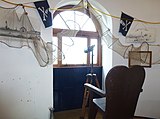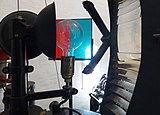Travemünde lighthouse
As a technical and structural cultural monument, the historic lighthouse of Travemünde no longer has any significance as a navigation mark , but is a landmark and museum for Travemünde together with the Passat .
In its current form, the red brick tower was built in 1827 in the classical style and is 31 m high. It is divided by five cornices , halfway up it has a small balcony as a pilot's lookout (from which the pilots used to look out for incoming ships) and in the uppermost part a narrow, circumferential platform .
History and technology
The first mention of an existing port character in Travemünde is Lübeck's imperial freedom letter included from 1226, with the Emperor Frederick II. Lübeck the Reichsunmittelbarkeit assured. The first reference to a beacon at the mouth of the Trave is documented for the year 1316 in the files of the council of the Hanseatic city through the mention of a beacon attendant (Latin custos lucerne ).
In 1534 the (first) lighthouse was destroyed by Danish troops during the count's feud .
The Travemünde lighthouse was rebuilt in 1539 and after a fire (triggered by lightning) in 1827, it was redesigned in a classical style. This makes it the oldest sea mark and the oldest lighthouse on the Bay of Lübeck and the German Baltic Sea coast . Its height is 31 meters and the mounting height is 30.6 meters.
In 1903 the beacon was switched from petroleum lamps to electric light with carbon arc lamps . From 1937 a cylindrical concave mirror (1.2 m wide and 55 cm high) increased the light from the incandescent lamp, which replaced the arc lamp from 1903. A lamp changing device with 1000 W / 24 V lamps was available for quick replacement of defective lamps. The nominal range was 16 nautical miles . Two otter screens gave the left side a lightning bolt identifier (1 s light + 2 s pause = 3 s return) and the right side a lightning group identifier. In 1954 and 2004 measures were taken to maintain the population.
Closed operation and museum
Germany's longest-serving lighthouse ceased operations in 1972 because the view was obscured by the new construction of the Maritim Hotel in Travemünde . Since April 30, 1974, the beacon has been on the Maritim Travemünde at 114.7 m above sea level. NN , making it the highest in Europe.
The old lighthouse is now a technical monument and has been a museum since 2004, in which, among other things, historical navigation signs as well as equipment from lightships and lighthouses are shown. Models of lightships, sea lanterns and lighting systems from other lighthouses can be seen on eight floors. On the top floor, which can be reached via 142 steps, the functional system of the old Travemünde lighthouse with its 1000 watt incandescent lamps has been preserved. The tower and museum are open to visitors.
A high water mark on the tower reminds of the severe flood of the Baltic Sea in 1872 , which hit Travemünde violently .
Pictures, old lighthouse Travemünde
Pictures, lighthouse museum
Others
The Leuchtenfeld is mentioned several times by Thomas Mann , who often spent his childhood holidays in Travemünde. It plays a role in the novel Buddenbrooks and is even the setting for almost everything in the story How Jappe and Do Escobar fought .
literature
- Detev Ellmers: The port sign of Travemünde . In: Lübeck 1226: Imperial Freedom and the Early City . Hansisches Verlagkontor Scheffler, Lübeck 1976, p. 57 ff .
See also
Individual evidence
- ↑ Travemünde lighthouse (new). On the website of the Lübeck Waterways and Shipping Office.
Web links
- Old Travemünde Lighthouse (Lübeck Waterways and Shipping Office)
- Peter Schemainda: Lübeck and the surrounding area. Lübeck 2005. (Chapter 3; PDF file; 1.46 MB)
Coordinates: 53 ° 57 ′ 37.8 " N , 10 ° 52 ′ 46" E











